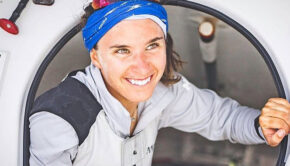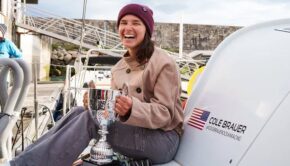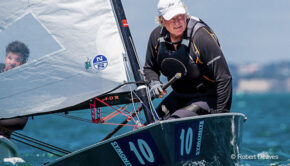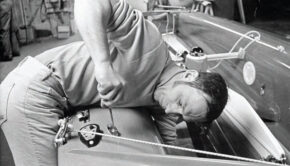Inject enthusiasm into handicap racing
Published on April 6th, 2020
As the early 2020 Sailing Calendar craters due to the COVID-19 pandemic, it gives more reason for enthusiasm toward what’s coming later in the year. In Seahorse magazine, Dobbs Davis sharpens our focus for the 2020 ORC/IRC World Championships on September 25 to October 3 in Newport, RI.
Everyone knows the center of gravity of this sport is in Europe, with its concentrated geography, diversity and wealth to support quality and inertia. Over 75 per cent of the IRC certificates and nearly 90 per cent of certificates issued by ORC in 2019 went to boats based in Europe.
So it’s not unreasonable that World Championships using the two systems have normally been located in Europe: the 2018 combined Worlds in The Hague had 85 entries from 15 countries and the 2019 ORC Worlds in Sibenik, Croatia had 109 entries from 17 countries.
Yet what about those who want to play at this level outside of Europe: should they never have the opportunity to compete at a venue outside their own culture?
Certainly there are credible levels of IRC and ORC competition and extremely talented sailors that come from Australia, New Zealand, Japan, North and even South America, yet the expense of shipping, training, and racing their own boats in Europe is a big stretch for all but the wealthiest teams.
It was Steve Benjamin in his role as the US representative in the ORC Congress that suggested three years ago that the regular cycle of toggling the Worlds between the Med and the Baltic be interrupted with locating the event where it had not been for nearly two decades: at the New York Yacht Club in Newport RI.
The 2016 mandate from World Sailing that the Worlds use both IRC and ORC on a biennial basis fit well with this idea since NYYC was already using both systems, and most agreed it was far too long the US had been away from hosting a major international event in handicap racing.
This does not mean, of course, that US sailing talent has been sleeping all these years: the size and scale of the domestic scene is so large that starting in the late ’90s the advent of offshore one design classes pulled many of those who used to race in the prevailing system of the era – IMS – into vibrant one design racing, a racing style that still dominates US keelboat racing as seen at the many race week events around the country.
Yet the popularity of one designs did take away most of the measurement rating culture around the US, which shrunk to being used mostly in larger offshore races held on either coast and the Great Lakes, thus affecting only hundreds and not thousands of boats as it had in the past.
This has slowly reversed, helped by the recent introduction of ORC use in local fleets – in 2019 nearly 300 ORC and 100 IRC certificates were issued by US Sailing.
Dual-scoring for the inshore races at the 2020 Worlds will use IRC ratings alongside ORC’s Performance Curve Scoring (PCS). Leg distances and wind directions are of course needed for PCS calculations, which should not be an issue given the advent of trackers and easier access for race committees to reliable wind data. Distance races will be scored with single-number choices from both systems.
It’s what happens next with results from ORC and IRC that is the tricky bit. However, the technical managers of both systems have agreed on a solution that is more clever than simply adding the points earned in both, as was done in The Hague.
The plan is to first score each race with each system’s ratings to get corrected time results to determine a winner. The corrected time of that winner is then ‘scratched’ – meaning set to zero – to allow corrected time differences to be determined with all the others. The difference in corrected time from the winning boat using ORC and IRC are then average and these results are used to create a new ranking list of final results.
This method was tested with the elapsed time data gathered in 2018 in The Hague and showed a fairly close match: the top boats were about the same in all classes and in all races, with some slight re-shifting of places deeper in the ranks.
This approach did help suppress some of the large disparities seen in some results, particularly in Class C, so it’s felt this will produce a fairer playing field for Newport in all classes.
Other challenges are in managing the details of how both systems can be used when the rules are just different in their approach.
For example, IRC presently rates free-luffed Code 0s tacked on the prod as a Headsail when the sail has less than 75% midgirth. This triggers a rating hit because the rule sees this as a headsail that could be used in any context, not just off the wind while reaching. In contrast, ORC rates sails smaller than this midgirth as what are called ‘Headsails set Flying,’ distinguishable from headsails that are tacked at the bow and attach to the headstay.
What this all means is that Code 0s built for use in both systems will need to be at the more restrictive IRC midgirth limit of 75% and count as spinnakers. This may not be a problem for the larger boats with four or more allowed spinnakers, but for smaller boats with inventory limits of three offwind sails, this could force difficult choice between which two to use among their A0, A1, and A3 sails.
And new this year in ORC is the rating gap now bridged between the largest spinnaker and largest headsail being rated at reaching angles: anyone with a Code 0-style spinnkaer in the range of 75-85% midgirth will now be required to have the sail measured and its contribution to performance will be rated in non-W/L races – for the Worlds this is two out of 8 in the schedule.
Regrettably in the last few weeks overseas teams originally entered from the UK, France, Germany, Italy and Argentina are starting to drop from the roster due to travel restrictions. Nonetheless, there are at least three new boats being built for this event with numerous design optimizations planned for existing designs; with luck this should all also help inject some greatly needed enthusiasm into the inshore handicap racing scene in the US!
Note: Seahorse, the dominant international magazine for anyone serious about their racing, is available by magazine subscription or iPad download: www.seahorse.co.uk/shop









 We’ll keep your information safe.
We’ll keep your information safe.